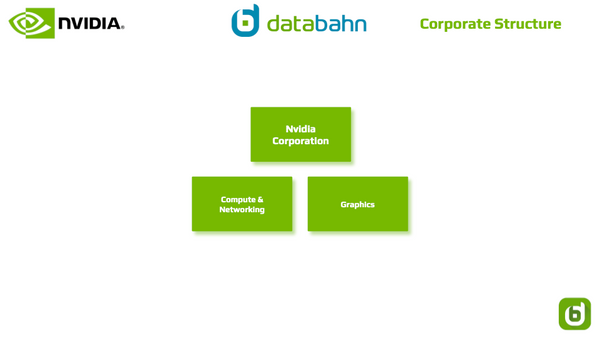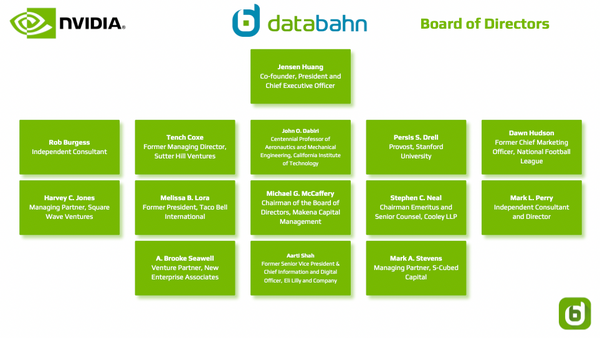NVIDIA Org Chart Report in 2025
NVIDIA Org Chart Report in 2025 | Decision-Maker Hierarchy Org Structure

Preview the NVIDIA Org Chart Report
NVIDIA Corporation
2788 San Tomas Expressway
Santa Clara, CA 95051
United States
Main Phone: (408) 486-2000
Website: https://www.nvidia.com
Industry Sector: Technology - Semiconductors
Full Time Employees: 36,000
Annual Revenues: $165.22 Billion USD
Fiscal Year End: January 26
CEO: Jen-Hsun Huang, Co-Founder, CEO, President & Director
Fortune 500 Rank: #31 in 2025
How would you describe the NVIDIA business in 2025?
Nvidia is a global technology company that specializes in artificial intelligence (AI), computer graphics, and high-performance computing. The company designs and manufactures a variety of products, including graphics processing units (GPUs), system-on-a-chips (SoCs), and software.
Nvidia's GPUs are used in a wide range of applications, including gaming, data centers, artificial intelligence, and self-driving cars. The company's SoCs are used in a variety of devices, including smartphones, tablets, and wearables. Nvidia's software is used to develop and deploy AI applications.
Nvidia is a leading player in the AI market. The company's GPUs are used to power AI applications in a variety of industries, including healthcare, finance, and manufacturing. Nvidia is also a leader in the data center market. The company's GPUs are used in data centers to accelerate a variety of workloads, including machine learning, deep learning, and high-performance computing.
Nvidia is a well-respected company with a strong track record of innovation. The company has a large and loyal customer base, and it is well-positioned to continue to grow in the years to come.
Here are some of the key business drivers for Nvidia:
- The growth of the AI market
- The increasing demand for high-performance computing
- The adoption of cloud computing
- The development of self-driving cars
- The growth of the gaming market
Nvidia is well-positioned to benefit from these trends. The company has a strong portfolio of products and solutions that address the needs of these markets. Nvidia is also a leader in innovation, and it is constantly developing new products and technologies to meet the needs of its customers.
Where can I purchase an NVIDIA Org Chart & Company Profile Report with NVIDIA Org Charts?
The databahn research team offer a deep dive Org Chart and Company Profile Report in the eStore. It includes detailed org charts, contact information, financial insights, business & technology drivers, a SWOT and PESTLE analysis, a technographic profile (IT vendors & products in use), IT budgets, and more. Check it out here.
Have there been any executive changes at NVIDIA in 2025?
Ellen Ochoa, Director, Board of Directors. Ellen Ochoa stepped down after six years of service effective August 5, 2025.
Simona Jankowski, Vice President, Investor Relations & Strategic Finance. Simona Jankowski departed NVIDIA for a CFO role at a startup effective August 5, 2024 (affected 2025 executive roster).
How would you describe the NVIDIA organizational structure?
NVIDIA employs a unique organizational framework, blending functional and matrix structures to optimize its operations. The corporation is structured into functional departments, encompassing critical areas like engineering, marketing, and sales. Alongside these, it operates temporary project teams assembled for precise initiatives.
The functional departments play a pivotal role in nurturing and enhancing NVIDIA's core competencies. For instance, the engineering department spearheads the design and development of NVIDIA's product portfolio, while the marketing department actively champions product promotion and sales.
Project teams, on the other hand, are tasked with tackling specific missions, such as creating innovative products or venturing into new markets. These teams comprise individuals from diverse functional backgrounds, enabling NVIDIA to harness a wide spectrum of expertise to address intricate challenges.
This hybrid arrangement empowers NVIDIA with the efficiency of functional departments, offering a structured resource framework, while also facilitating swift responses to market dynamics through adaptable project teams.
For a more comprehensive view of NVIDIA's organizational structure, let's delve into its various tiers:
- Board of Directors: NVIDIA's board of directors exercises comprehensive oversight over the corporation. Comprising independent directors with no NVIDIA employment ties, this body ensures robust governance.
- Executive Team: Steering the day-to-day operations, the executive team, under the leadership of the CEO, includes other senior executives, steering the company's strategic vision.
- Functional Departments: Critical to the maintenance of NVIDIA's core competencies, these departments span engineering, marketing, sales, finance, and human resources, all working cohesively to drive excellence.
- Project Teams: Focused on targeted missions, project teams often comprise cross-functional personnel, leveraging varied expertise to tackle specific challenges.
NVIDIA has meticulously designed its organizational structure to facilitate the realization of its ambitions as a premier provider of accelerated computing solutions. This structure ingeniously combines efficiency and flexibility, vital attributes in a rapidly evolving industry landscape.
Does databahn offer more comprehensive NVIDIA Org Charts and other account intelligence?
Yes, databahn researches and updates the NVIDIA Org Chart & Sales Intelligence Report about once per quarter. We also offer customizations to the org charts and other report sections. Some of the line of business org charts we research, build and maintain include Information Technology, Human Resources, Supply Chain, Purchasing/Procurement, and Financial Operations.
Visit the NVIDIA Org Chart Report webpage to learn more.
NVIDIA Corporate Structure Org Chart
Who are the top executives on the Nvidia org chart?
NVIDIA Executive Leadership Team
| NAME | TITLE | COMPANY | PHONE | |
| Jensen Huang | Founder, President, and CEO | NVIDIA | (408) 486 2000 | [f][last]@nvidia.com |
| Colette Kress | EVP and Chief Financial Officer | NVIDIA | (408) 486 2000 | [f][last]@nvidia.com |
| Debora Shoquist | EVP, Operations | NVIDIA | (408) 486 2000 | [f][last]@nvidia.com |
| Jay Puri | EVP, Worldwide Field Operations | NVIDIA | (408) 486 2000 | [f][last]@nvidia.com |
| Chris A. Malachowsky | Founder and NVIDIA Fellow | NVIDIA | (408) 486 2000 | [f][last]@nvidia.com |
| Tim Teter | SVP, General Counsel and Secretary | NVIDIA | (408) 486 2000 | [f][last]@nvidia.com |
Where can I purchase an NVIDIA Contact Information Spreadsheet?
The databahn research team have compiled a spreadsheet list of hundreds of NVIDIA contacts. It's available in the eStore. It includes contact information from multiple departments including Engineering, Operations, Marketing, IT - Information Technology, Research, Finance, Human Resources, Legal and Facilities. Check it out here.
Who are the Board of Directors on the NVIDIA org chart?
NVIDIA Board of Directors & Their Affiliations
| NAME | TITLE | DESCRIPTION | COMPANY | PHONE | |
| Stephen C. Neal | Board Member | Chairman Emeritus and Senior Counsel, Cooley LLP | NVIDIA | (408) 486 2000 | [f][last]@nvidia.com |
| Michael G. McCaffery | Board Member | Chairman of the Board of Directors, Makena Capital Management | NVIDIA | (408) 486 2000 | [f][last]@nvidia.com |
| Jensen Huang | Board Member | Co-founder, President and Chief Executive Officer | NVIDIA | (408) 486 2000 | [f][last]@nvidia.com |
| Dawn Hudson | Board Member | Former Chief Marketing Officer, National Football League | NVIDIA | (408) 486 2000 | [f][last]@nvidia.com |
| Tench Coxe | Board Member | Former Managing Director, Sutter Hill Ventures | NVIDIA | (408) 486 2000 | [f][last]@nvidia.com |
| Melissa B. Lora | Board Member | Former President, Taco Bell International | NVIDIA | (408) 486 2000 | [f][last]@nvidia.com |
| Aarti Shah | Board Member | Former Senior Vice President & Chief Information and Digital Officer, Eli Lilly and Company | NVIDIA | (408) 486 2000 | [f][last]@nvidia.com |
| Rob Burgess | Board Member | Independent Consultant | NVIDIA | (408) 486 2000 | [f][last]@nvidia.com |
| Mark L. Perry | Board Member | Independent Consultant and Director | NVIDIA | (408) 486 2000 | [f][last]@nvidia.com |
| Mark A. Stevens | Board Member | Managing Partner, S-Cubed Capital | NVIDIA | (408) 486 2000 | [f][last]@nvidia.com |
| Harvey C. Jones | Board Member | Managing Partner, Square Wave Ventures | NVIDIA | (408) 486 2000 | [f][last]@nvidia.com |
| Persis S. Drell | Board Member | Provost, Stanford University | NVIDIA | (408) 486 2000 | [f][last]@nvidia.com |
| A. Brooke Seawell | Board Member | Venture Partner, New Enterprise Associates | NVIDIA | (408) 486 2000 | [f][last]@nvidia.com |
| John O. Dabiri | Board Member | Centennial Professor of Aeronautics and Mechanical Engineering, California Institute of Technology | NVIDIA | (408) 486 2000 | [f][last]@nvidia.com |
Who is the Chief Executive Officer of Nvidia in 2025?

Jensen Huang stands as the visionary founder of NVIDIA, a company that came into being in 1993, and from its inception, he has held the pivotal roles of President, Chief Executive Officer, and a member of the board of directors.
NVIDIA's journey has been marked by groundbreaking innovations in accelerated computing. Notably, the company's introduction of the GPU in 1999 sparked a revolution in the PC gaming market, redefined the realm of computer graphics, and ushered in the era of modern AI. Today, NVIDIA is at the forefront of driving the platform evolution of accelerated computing and generative AI, catalyzing transformation across the world's largest industries and leaving a profound impact on society.
Jensen Huang's remarkable contributions have earned him esteemed accolades, including the Semiconductor Industry Association's prestigious Robert N. Noyce Award, the IEEE Founder's Medal, and the Dr. Morris Chang Exemplary Leadership Award. He also holds honorary doctorate degrees from distinguished institutions such as Taiwan's National Chiao Tung University, National Taiwan University, and Oregon State University. His exceptional leadership has been acknowledged by being named the world's best CEO by Harvard Business Review and Brand Finance, and he has received the title of Fortune's Businessperson of the Year, along with recognition as one of TIME magazine's 100 most influential people.
Before embarking on his journey with NVIDIA, Jensen Huang gained valuable experience at LSI Logic and Advanced Micro Devices. He is equipped with a Bachelor of Science degree in Electrical Engineering (BSEE) from Oregon State University, and he furthered his academic pursuit with a Master of Science degree in Electrical Engineering (MSEE) from Stanford University.
Who is the Chief Financial Officer of NVIDIA in 2025?

Colette Kress holds the position of Executive Vice President and Chief Financial Officer at NVIDIA, a role she assumed in September 2013. Prior to joining NVIDIA, she garnered extensive finance experience over the course of nearly 25 years at prominent technology companies.
Before her tenure at NVIDIA, Colette served as Senior Vice President and Chief Financial Officer within Cisco's Business Technology and Operations Finance organization for a span of three years. In this capacity, she played a pivotal role in shaping financial strategy, overseeing planning and reporting, and driving business development across all business segments, engineering, and operations.
Colette's career path also includes an impressive 13-year stint at Microsoft. During her time there, she held the position of Chief Financial Officer for the Server and Tools division for four years and assumed senior roles in corporate planning and finance. Prior to her tenure at Microsoft, she contributed her financial expertise to Texas Instruments, holding various finance positions.
Colette Kress's educational background is underscored by a B.Sc. degree in finance earned from the University of Arizona, complemented by an MBA from Southern Methodist University.
What companies is NVIDIA partnering with advance AI?

The world's most extensive democracy is on the verge of a monumental transformation, positioning itself to embrace AI technology on an unprecedented scale.
During a press conference in Bengaluru, against the backdrop of significant announcements from two of India's largest corporate giants, Reliance Industries Limited and Tata Group, Jensen Huang, the visionary founder and CEO of NVIDIA, outlined ambitious plans to introduce AI technology and expertise to tackle the most pressing challenges facing the world's most populous nation.
Huang expressed his conviction that India is destined to become one of the global hubs for AI innovation, stating, "I believe this will emerge as one of the world's largest AI markets." His remarks came as he concluded a week of high-level engagements across India, including meetings with Prime Minister Narendra Modi, leading AI researchers, prominent business leaders, interactions with the media, and discussions with the extensive NVIDIA team comprising over 4,000 members in the country.
Under this collaboration, the two conglomerates will pool their resources to establish a robust AI computing infrastructure and cutting-edge platforms designed for the development of AI solutions. This initiative will draw upon NVIDIA's advanced technology, including the revolutionary NVIDIA GH200 Grace Hopper Superchip and the innovative NVIDIA DGX Cloud.
The GH200 marks a groundbreaking shift in computing architecture, delivering exceptional performance and monumental memory bandwidth. In parallel, the DGX Cloud, a cloud-based AI supercomputing service, will streamline the process of training employees in AI technology for enterprises, facilitate internal accessibility to AI resources, and offer generative AI services to clients, promoting a transformative shift in the AI landscape.
What new initiatives has Nvidia launched recently?

On Tuesday, Nvidia made an exciting announcement about enhancements to its cutting-edge artificial intelligence chips aimed at accelerating generative AI applications.
The latest iteration of the Grace Hopper Superchip brings a significant increase in high-bandwidth memory capacity, a crucial development that empowers this design to support larger AI models, as explained by Ian Buck, Nvidia's Vice President of Hyperscale and HPC. This optimized configuration is tailored to excel in AI inference tasks, which are fundamental to driving generative AI applications like ChatGPT.
The architecture of Nvidia's Grace Hopper Superchip seamlessly combines one of the company's H100 graphics processing units (GPU) with a specially designed Nvidia central processor.
As Ian Buck elaborated in a conference call with journalists, "Expanding the memory capacity allows the model to reside on a single GPU, eliminating the need for multiple systems or GPUs to run the application effectively."
The AI models underpinning generative AI applications, capable of producing human-like text and images, have been growing in complexity and size. With this growth, they demand more memory to operate efficiently without relying on separate chips and systems, which can degrade performance.
Buck emphasized, "The additional memory simply amplifies the GPU's performance."
This revamped configuration, known as GH200, is set to be available in the second quarter of the upcoming year, according to Buck.
Nvidia intends to offer two variants: one featuring two chips that customers can seamlessly integrate into their systems and another comprising a complete server system that harnesses the power of two Grace Hopper designs.
What companies is Nvidia currently working with?

Nvidia and MediaTek announced a partnership on Monday to develop advanced vehicle infotainment systems. The collaboration will combine Nvidia's GPU and AI technology with MediaTek's system-on-chip (SoC) expertise to create powerful and customizable infotainment systems for a wide range of vehicles.
The first products from the partnership are expected to be released in late 2025. They will be designed to support a variety of advanced features, such as streaming video and games, interacting with drivers using artificial intelligence, and displaying the environment around the vehicle. The systems will also be compatible with automated driving systems based on Nvidia technology.
"The automotive industry needs strong companies that can work with the industry for decades at a time," said Nvidia CEO Jensen Huang. "The quality, strength and positions of our two companies could give the automotive industry partners that they can build their companies on."
The partnership between Nvidia and MediaTek is a major step forward in the development of advanced vehicle infotainment systems. It brings together two of the leading companies in their respective fields to create a powerful and versatile platform that can be customized to meet the needs of a wide range of automakers.
Here are some specific ways that the partnership will benefit automakers:
- It will give them access to Nvidia's leading GPU and AI technology, which can be used to create high-performance and immersive infotainment experiences.
- It will allow them to customize infotainment systems to meet the specific needs of their vehicles and customers.
- It will give them a single source for infotainment systems, which can help to reduce costs and complexity.
The partnership between Nvidia and MediaTek is a significant development in the automotive industry. It is a sign of the growing importance of technology in vehicles, and it is likely to lead to the development of more advanced and innovative infotainment systems in the years to come.
Databahn Client Testimonials
"The account insights are pure gold. I especially like the Contact Info spreadsheet. I'm using the deep dive report daily and even more so now as my QBR approaches next week." - Client Executive at Fortune 1000 Technology Company






